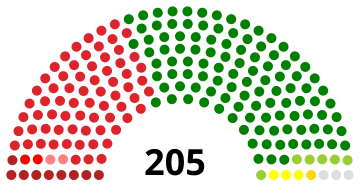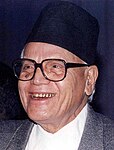 | ||||||||||||||||||||||
| ||||||||||||||||||||||
| ← outgoing memberselected members → | ||||||||||||||||||||||
All 205 seats in the House of Representatives 103 seats needed for a majority | ||||||||||||||||||||||
|---|---|---|---|---|---|---|---|---|---|---|---|---|---|---|---|---|---|---|---|---|---|---|
| Turnout | 65.15% | |||||||||||||||||||||
| ||||||||||||||||||||||
| ||||||||||||||||||||||
General elections were held in Nepal on 12 May 1991, to elect 205 members to the House of Representatives. The elections were the first multi-party elections since 1959 and were a result of the 1990 revolution forcing King Birendra to restore a multi-party system.
Although the Nepali Congress won the most seats, its leader Krishna Prasad Bhattarai lost in his own constituency, Kathmandu 1. Communist leader Madan Kumar Bhandari was elected in both Kathmandu 1 and Kathmandu 5, vacating the latter.
Results
 | ||||
|---|---|---|---|---|
| Party | Votes | % | Seats | |
| Nepali Congress | 2,752,452 | 39.50 | 110 | |
| Communist Party of Nepal (Unified Marxist–Leninist) | 2,040,102 | 29.27 | 69 | |
| Rastriya Prajatantra Party (Chand) | 478,604 | 6.87 | 3 | |
| Rashtriya Prajatantra Party (Thapa) | 392,499 | 5.63 | 1 | |
| United People's Front of Nepal | 351,904 | 5.05 | 9 | |
| Nepal Sadbhavana Party | 298,610 | 4.28 | 6 | |
| Communist Party of Nepal (Democratic) | 177,323 | 2.54 | 2 | |
| Nepal Workers Peasants Party | 91,335 | 1.31 | 2 | |
| Rastriya Janamukti Party | 34,509 | 0.50 | 0 | |
| Communist Party of Nepal (Burma) | 16,698 | 0.24 | 0 | |
| Janata Dal (Samajbadi Prajatantrik) | 5,760 | 0.08 | 0 | |
| Nepal Rastriya Jana Party | 5,732 | 0.08 | 0 | |
| Communist Party of Nepal (Amatya) | 4,846 | 0.07 | 0 | |
| Rastriya Janata Party (H) | 4,406 | 0.06 | 0 | |
| Rastriya Janata Party (Nepal) | 4,280 | 0.06 | 0 | |
| Nepal Conservative Party | 2,562 | 0.04 | 0 | |
| Bahu Jana Janatadal | 2,012 | 0.03 | 0 | |
| Janawadi Morcha Nepal | 1,518 | 0.02 | 0 | |
| Ekata Party | 94 | 0.00 | 0 | |
| Dalit Majdoor Kisan Party | 92 | 0.00 | 0 | |
| Independents | 303,723 | 4.36 | 3 | |
| Total | 6,969,061 | 100.00 | 205 | |
| Valid votes | 6,969,061 | 95.58 | ||
| Invalid/blank votes | 322,023 | 4.42 | ||
| Total votes | 7,291,084 | 100.00 | ||
| Registered voters/turnout | 11,191,777 | 65.15 | ||
| Source: Nohlen et al., IFES | ||||
Aftermath
Following the result of the election, Nepali Congress came to power and Girija Prasad Koirala became Prime Minister. The house met for the first time in May 1991. Daman Nath Dhungana served as the Speaker of the House. The parliament could not complete its full five-year term with Koirala asking King Birendra to dissolve the house in July 1994 after losing a no-confidence motion with some member of his own party voting against him.
See also
References
- "Kingdom of Nepal: Parliamentary Elections, May 12, 1991". www.ifes.org. Retrieved 2020-12-12.
- "NEPAL'S CABINET IS OUSTED BY KING; Mahendra Seizes Ministers as 'Anti-Nationalists' and Dissolves Parliament NEPAL'S CABINET IS OUSTED BY KING (Published 1960)". The New York Times. 1960-12-16. ISSN 0362-4331. Retrieved 2020-12-12.
- Election history of Nepal (नेपालको निर्वाचन इतिहास) [Election history of Nepal] (in Nepali). Kathmandu: Election Commission Nepal. 2017. pp. 634–640. ISBN 978-9937-0-2116-6.
- "Nepal Picks Prime Minister, In Transition to Democracy (Published 1991)". The New York Times. 1991-05-30. ISSN 0362-4331. Retrieved 2020-12-12.
- "Dhungana makes a comeback to politics after 23 years". kathmandupost.com. Retrieved 2020-12-12.
- "NEPAL: parliamentary elections Pratinidhi Sabha, 1994". archive.ipu.org. Retrieved 2020-12-12.
- Moore, Molly (1994-07-12). "NEPAL'S GOVERNMENT COLLAPSES AS KING DISSOLVES LEGISLATURE". Washington Post. ISSN 0190-8286. Retrieved 2020-12-12.
| General elections | |
|---|---|
| Provincial elections | |
| Local elections | |
| Referendums | |

